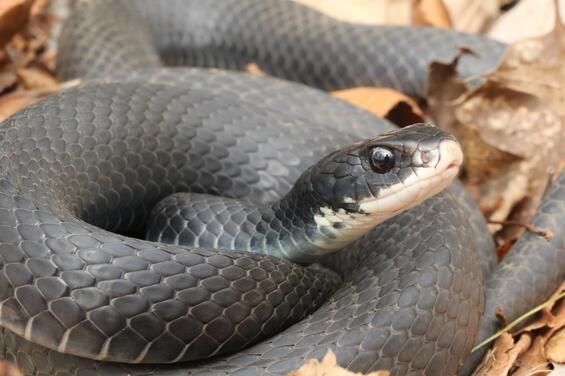- Scientific name: Coluber constrictor
Species of Greatest Conservation Need (MA State Wildlife Action Plan)

Adult North American racer, showing smooth scales, round pupils, and white chin.
Description
The North American racer is a large, relatively slender snake, highly active and diurnal in its habits. Adults are solid black except for a white or gray chin, throat and jaw. It is the only large black snake with smooth scales in Massachusetts. Young are gray and heavily patterned with large brown, black, or reddish blotches down the center of the back; smaller blotches along the sides. The juvenile pattern fades to black after about a year of age. Adults range from 92-179+ cm (36-70+ in) in total length. Mating activity and what appears to be some form of male dominance hierarchy determination has been observed in the spring immediately following emergence, but mating also occurs in late summer and fall. Females deposit 10 to 15 eggs in June or July that normally hatch in August or early September.
This alert, sight-hunting reptile was once a familiar animal to most state residents. It is noted for displaying curiosity, but it is quick to take alarm and flee rapidly when approached. When cornered or too cold to take flight, it coils and vibrates its tail rapidly.
Life cycle and behavior
Mating takes place in spring. Females deposit clutches of 8-20+ eggs in rotting logs or other damp, warm, concealed sites in June and July. The young, roughly 22-30 cm (9-12 in) long at hatching, emerge in August or September. They eat small mammals, insects, amphibians, snakes, bird eggs, and nestlings. Racers are not constrictors, but they can hold prey down with a loop of their bodies. As their name suggests, racers are very fast. They are not venomous, and they typically flee from danger. If they feel trapped, they will fight, bite, or rattle their tails in dry leaves to mimic rattlesnakes.
Population status
The North American racer does not have a federal conservation status under the U.S. Endangered Species Act. However, it is recognized as a species of greatest conservation need in Massachusetts due to observed declines.
Distribution and abundance
This species appears to range throughout most of the state except Nantucket but has now undoubtedly been extirpated from most populous areas. It is still locally abundant in some areas, particularly in some southeastern portions of the state, but has declined markedly in range and numbers over the past three decades.
Habitat
This species is a generalist in terms of both habitat and prey, but in New England is probably most closely associated with dry, upland forest habitats. The most abundant numbers appear to reside in the scrub oak/pitch pine barrens and bordering habitats of Cape Cod and Martha’s Vineyard. There are several known “artificial” hibernacula harboring numerous individuals in the central part of the state, all created when dams, dikes, or mining waste resulted in the creation of very large (1+ acre) piles of rock and gravel. It is unclear if inland populations actually require deep crevice/talus slope hibernacula; they certainly do not in the southeastern portion of the state. The species feeds on a great variety of prey including small mammals, birds, eggs, insects, fish, amphibians, and snakes.
Healthy habitats are vital for supporting native wildlife and plants. Explore habitats and learn about conservation and restoration in Massachusetts.
Threats
The major threat to this species is undoubtedly the proliferation of roads and ever-increasing traffic. These active animals have large home range areas, they are frequently on the move, and they will use road surfaces as basking sites. All these factors result in ever-increasing road mortality, and many areas that formerly supported abundant populations now appear devoid of the species. Continued fragmentation of the landscape by roads and development is extirpating this species from large areas of its range, theoretically, but in the absence of baseline data, the degree of threat is impossible to determine. It is unknown if the unnaturally high-density populations of “human commensals,” such as raccoon, skunk, and fox, encouraged by development also play a role in North American racer decline. Research is required to determine more about the abundance, decline, distribution, and core habitat requirements of this species.
Conservation
Racers will benefit most from the adequate protection and management of rocky uplands in the Connecticut Valley and sandy outwash areas on Cape Cod, southeastern Massachusetts, and Martha’s Vineyard. This species will benefit from habitat management that improves the availability of edge habitats and may also respond to the artificial creation of overwintering areas.
References
Klemens, M. W. 1993. Amphibians and Reptiles of Connecticut and Adjacent Regions. State Geological and Natural History Survey of Connecticut, Bulletin 112. Connecticut Dept. Environmental Protection, Hartford, Connecticut.
Contact
| Date published: | April 17, 2025 |
|---|